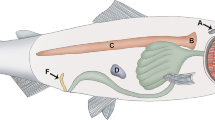Abstract
We report for the first time the development and morphological characteristics of the spleen thymus, lymph nodes and liver of the northern brown bandicoot, Isoodon macrourus. To date few marsupial species have been studied. The development and morphological characteristics of the organs shared the typical features of those few other marsupials studied as well as those of eutherians. These suggest comparative functional properties with the eutherian immune system. The thymus differentiated within the first week of pouch life and showed evidence of immunolymphopoiesis up to juvenile stages. The spleen, though seeded by lymphocytes within the first week of pouch life, was slower to mature, but differentiated and showed signs of immunocompetency by the time young left the pouch. The mature spleen displayed the same anatomical blood filtering and immunosurveillance properties as that of the eutherian spleen, with evidence of erythrocyte destruction, thrombopoietic activity, activation and differentiation of immunocompetent lymphocytes. However, the absence of sheathed capillary structures in the spleen may indicate differences in the humoral response to circulating antigens. Similarly, lymph nodes also mature by this stage with anterior nodes appearing before posterior nodes. The mature lymph nodes displayed structural features of secondary immuno-lymphoid organs consistent with production of immune responses. Finally, the liver displayed haemopoietic activity for the first four weeks of pouch life. The pattern of development in the bandicoot appears to parallel the pattern reported for other marsupials, yet the thymus matures considerably earlier than previously reported and may be of significance in the development and onset of cell-mediated immunity. Current studies to characterise cellular components, such as T/B lymphocyes and accessory cells of these organs will help to define the mechanisms of immune recognition, activation and hence outline the asis of the marsupial humoral and cellular immunity.
Similar content being viewed by others
Author information
Authors and Affiliations
Additional information
Accepted: 16 March 1999
Rights and permissions
About this article
Cite this article
Cisternas, P., Armati, P. Development of the thymus, spleen, lymph nodes and liver in the marsupial, Isoodon macrourus (Northern brown bandicoot, Peramelidae). Anat Embryol 200, 433–443 (1999). https://doi.org/10.1007/s004290050293
Issue Date:
DOI: https://doi.org/10.1007/s004290050293




